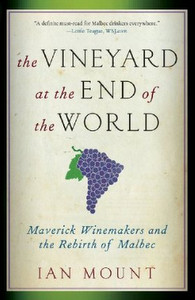|
Wine
book reviews
The vineyard at
the end of the world
Ian Mount
 In
the vineyard at the end of the world, Ian Mount tells the story of
the modern Argentine wine industry. He begins at the beginning,
tracing the history of winegrowing in Argentina, but after some
worthy but slightly dull chapters, things begin to get very
interesting. In
the vineyard at the end of the world, Ian Mount tells the story of
the modern Argentine wine industry. He begins at the beginning,
tracing the history of winegrowing in Argentina, but after some
worthy but slightly dull chapters, things begin to get very
interesting.
Mount lives in
Argentina, and his research has been meticulous. Itís the
portrayal of the characters he has met and spent some time with that
really brings this book to life, and a particular focus is on the
Catena family. Indeed, the role Catena has played in developing
Argentinaís modern wine industry is the central thread throughout
the book.
I was interested
to learn that in 1979 Catena sold their family business to Hťctor
Greco. Greco was at time the biggest player in the Argentine wine
industry and also the owner of a bank. Greco outflanked other
players in the wine business by paying progressively more for
grapes, at a time when consumption was actually decreasing: this
made the growers happy but drove many of his competitors out of
business.
In 1979 Greco
offered the Catena family $129 million for their bodega, a price
they couldnít refuse. But this purchase price was divided up into
10 payments, and the transfer of majority ownership to Greco was
only to be triggered by the last instalment. Apparently, Greco had
made seven payments before he was arrested by the military
dictatorship and taken to prison. Catena did very well out of the
deal: they got their winery back, plus they held onto a significant
sum of Grecoís money.
Through the book,
Mount traces the growth of what was an isolated and rather backward
wine industry into what it is today, interviewing key players, and
bringing a strong narrative theme to the whole account. He writes
for the general reader, trying his best to explain all the wine
terminology and jargon with some success. I learned a good deal, and
the historical context provided by Mountís book has helped me to a
better understanding of Argentine wines, even though I have visited
and tasted lots of them.
The emphasis on
Catena could have unbalanced the book, but although Mount clearly
had a lot of access to Catena he avoids sycophancy. Itís a warts
and all account. For example, he doesnít shy away from mentioning
how Paul Hobbs, the Californian consultant behind the wines that
propelled Catena onto the international stage, has been airbrushed
out of the official Catena history.
If you have any
interest in Argentine wine, this book comes highly recommended.
To Buy:
 Back
to book review section Back
to book review section
 Older book reviews Older book reviews
Back
to top
|

